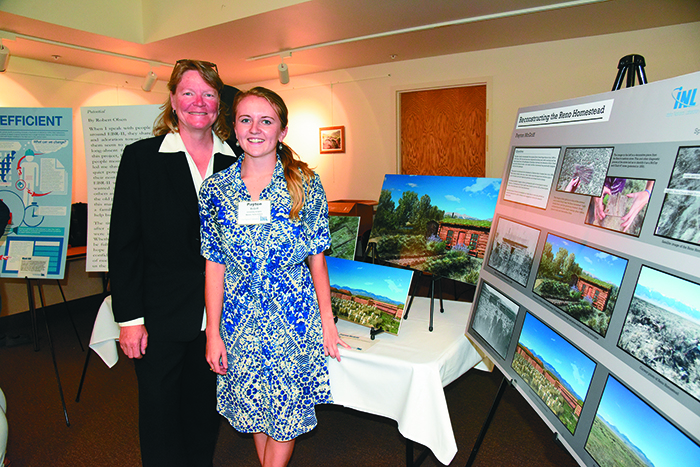
Idaho Falls High School graduate Payton McGriff spent last summer working as an intern in INL’s Cultural Resources Management Program. Her responsibilities included identifying and establishing the historic significance of roads within INL boundaries. Many of them have not been used for more than 100 years. For McGriff, it’s a unique challenge, which combines INL’s rich history with her education as a senior at University of Idaho pursuing a bachelor’s degree in architecture.
“At first, I wondered, ‘What am I going to learn from this internship that will help me to be a better designer or architect?’ ” McGriff said. “It didn’t take me long to realize that architecture is inherently collaborative, and getting experience from other disciplines could help any designer.”
Through her internship with INL’s Cultural Resources team, McGriff developed a passion she never knew she had.
“Learning about all the different aspects of cultural resources and archaeology is
extremely valuable because it shows how preservation can be an integral part of design,” she said. “As architects, we often focus on the creation aspect of design so intently that we forget about the potential for preservation. This internship has broadened my perspective while helping to establish a deeper appreciation for modern and historic cultures.”
This new passion for preservation is also what led to an idea for McGriff’s Intern Final Project. At the end of the summer, each INL intern summarizes their project on a traditional research poster or through an art project — an approach the lab piloted in 2015.
McGriff’s intern project focused on re-creating a 3-dimensional model of the historic Birch Creek landscape and homestead. The model combined historic imagery, archaeological evidence and architectural software.
The Torrey Reno family began homesteading the original Birch Creek Stage Station in 1886, and turned it into one of the most successful sheep ranching operations of that time. McGriff’s project covers the time the Reno family owned the property, starting around 1886. Before her internship began, Hollie Gilbert, McGriff’s mentor, had done a great deal of research on the homestead and Reno family. Gilbert located the descendants to obtain historic photos and documents that provide detail for a portion of the Reno homestead.
McGriff and Gilbert focused on piecing together the available information and filling in the gaps with archaeological evidence. McGriff then used the information and photos to build a virtual 3-D model of the entire homestead that will eventually be uploaded to the immersive Computer-Assisted Virtual Environment (CAVE) at the Center for Advanced Energy Studies.
Piecing together that information was one of the biggest challenges of McGriff’s internship. Developing an archaeological perspective takes time and experience. Every day brings a new challenge of sorting out the information to tell history’s stories.
“The ability to imagine the story behind a rusted can is a unique skill that I have a great appreciation for, but I’ve yet to develop fully,” McGriff said.
Having a 3-D model of the homestead is important for several reasons. The amount of information compiled in archaeological research is vast, and a 3-D model allows the information to be viewed and analyzed in a more comprehensive, relatable context.
Also, visual tools like 3-D models are becoming increasingly important in community outreach. It can be difficult to convey the entire story embodied in the archaeological evidence without some sort of visual aid. A 3-D model and imagery is another valuable tool for telling historic stories. A virtual medium like the CAVE allows people to interact with history in a way they haven’t had access to in the past.
Historic information is abundant at the INL Site, parts of which have been closed to public access for more than 70 years. That’s why the Site is also a National Environmental Research Park — protecting its resources is part of INL’s Environmental Policy.
The policy states, “Through employee involvement and management commitment to environmental excellence, we will exercise world-leading environmental stewardship to protect the unique natural, biological and cultural resources of the lands and facilities managed by INL.”
One way to protect cultural resources is through research. Understanding how a homestead fits within the landscape begins to reveal how people from the past used the limited resources available to them. By reconstructing the historic site, viewers can experience what the landscape looked like with buildings, water and vegetation. Also, the simulation gives the public a tangible view, which can foster more appreciation and incentive to protect the resource.
McGriff said her internship has been so much more than a summer job and she wouldn’t trade the opportunities she has experienced for anything.
“The connections I’ve made and the support I’ve felt from this department have been such rewarding aspects of my internship, but I think the best part is the creative freedom I was given and the passion that has resulted from that,” she said. “I love being a part of making history accessible in a modern landscape. The merging of the modern technology with historical artifacts is a creative experience unlike anything I’ve experienced so far.”